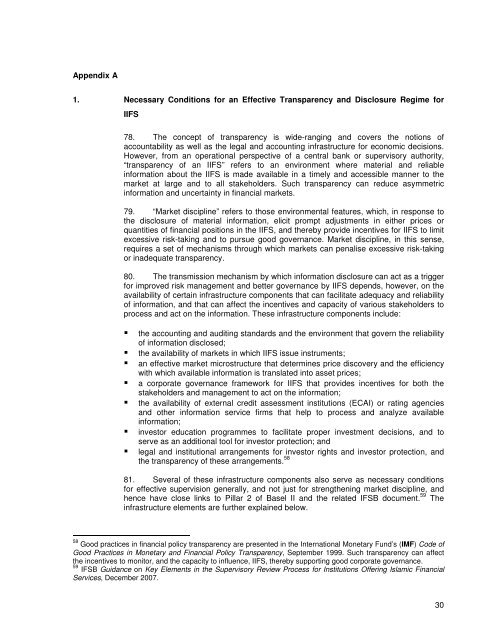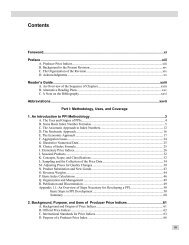Disclosures to Promote Transparency and Market - IFSB
Disclosures to Promote Transparency and Market - IFSB
Disclosures to Promote Transparency and Market - IFSB
You also want an ePaper? Increase the reach of your titles
YUMPU automatically turns print PDFs into web optimized ePapers that Google loves.
Appendix A<br />
1. Necessary Conditions for an Effective <strong>Transparency</strong> <strong>and</strong> Disclosure Regime for<br />
IIFS<br />
78. The concept of transparency is wide-ranging <strong>and</strong> covers the notions of<br />
accountability as well as the legal <strong>and</strong> accounting infrastructure for economic decisions.<br />
However, from an operational perspective of a central bank or supervisory authority,<br />
“transparency of an IIFS” refers <strong>to</strong> an environment where material <strong>and</strong> reliable<br />
information about the IIFS is made available in a timely <strong>and</strong> accessible manner <strong>to</strong> the<br />
market at large <strong>and</strong> <strong>to</strong> all stakeholders. Such transparency can reduce asymmetric<br />
information <strong>and</strong> uncertainty in financial markets.<br />
79. “<strong>Market</strong> discipline” refers <strong>to</strong> those environmental features, which, in response <strong>to</strong><br />
the disclosure of material information, elicit prompt adjustments in either prices or<br />
quantities of financial positions in the IIFS, <strong>and</strong> thereby provide incentives for IIFS <strong>to</strong> limit<br />
excessive risk-taking <strong>and</strong> <strong>to</strong> pursue good governance. <strong>Market</strong> discipline, in this sense,<br />
requires a set of mechanisms through which markets can penalise excessive risk-taking<br />
or inadequate transparency.<br />
80. The transmission mechanism by which information disclosure can act as a trigger<br />
for improved risk management <strong>and</strong> better governance by IIFS depends, however, on the<br />
availability of certain infrastructure components that can facilitate adequacy <strong>and</strong> reliability<br />
of information, <strong>and</strong> that can affect the incentives <strong>and</strong> capacity of various stakeholders <strong>to</strong><br />
process <strong>and</strong> act on the information. These infrastructure components include:<br />
the accounting <strong>and</strong> auditing st<strong>and</strong>ards <strong>and</strong> the environment that govern the reliability<br />
of information disclosed;<br />
the availability of markets in which IIFS issue instruments;<br />
an effective market microstructure that determines price discovery <strong>and</strong> the efficiency<br />
with which available information is translated in<strong>to</strong> asset prices;<br />
a corporate governance framework for IIFS that provides incentives for both the<br />
stakeholders <strong>and</strong> management <strong>to</strong> act on the information;<br />
the availability of external credit assessment institutions (ECAI) or rating agencies<br />
<strong>and</strong> other information service firms that help <strong>to</strong> process <strong>and</strong> analyze available<br />
information;<br />
inves<strong>to</strong>r education programmes <strong>to</strong> facilitate proper investment decisions, <strong>and</strong> <strong>to</strong><br />
serve as an additional <strong>to</strong>ol for inves<strong>to</strong>r protection; <strong>and</strong><br />
legal <strong>and</strong> institutional arrangements for inves<strong>to</strong>r rights <strong>and</strong> inves<strong>to</strong>r protection, <strong>and</strong><br />
the transparency of these arrangements. 58<br />
81. Several of these infrastructure components also serve as necessary conditions<br />
for effective supervision generally, <strong>and</strong> not just for strengthening market discipline, <strong>and</strong><br />
hence have close links <strong>to</strong> Pillar 2 of Basel II <strong>and</strong> the related <strong>IFSB</strong> document. 59 The<br />
infrastructure elements are further explained below.<br />
58 Good practices in financial policy transparency are presented in the International Monetary Fund’s (IMF) Code of<br />
Good Practices in Monetary <strong>and</strong> Financial Policy <strong>Transparency</strong>, September 1999. Such transparency can affect<br />
the incentives <strong>to</strong> moni<strong>to</strong>r, <strong>and</strong> the capacity <strong>to</strong> influence, IIFS, thereby supporting good corporate governance.<br />
59 <strong>IFSB</strong> Guidance on Key Elements in the Supervisory Review Process for Institutions Offering Islamic Financial<br />
Services, December 2007.<br />
30
















